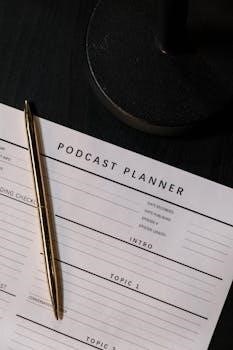
Equivalent Ratios Worksheet PDF⁚ A Comprehensive Guide
Equivalent ratios are a fundamental concept in mathematics, particularly
for students in grades 3-10. Our comprehensive guide provides printable
PDF worksheets with answer keys, online generators, and Google Sheets
practice.
Understanding Equivalent Ratios
Equivalent ratios express the same proportional relationship between two
quantities. They are essential for understanding proportions and solving
related problems. Identifying equivalent ratios involves recognizing
that they can be simplified or expanded to the same form, much like
equivalent fractions.
To determine if two ratios are equivalent, you can simplify both to
their simplest form or use cross-multiplication. Equivalent ratios are
crucial in various real-world applications, from scaling recipes to
determining map distances. Mastering this concept lays a solid foundation
for advanced mathematical topics. Our worksheets offer practice in
identifying, writing, and applying equivalent ratios.
They help students grasp the core principles and build confidence in solving
problems involving proportions. This understanding is vital for success in
future math studies.
Identifying Equivalent Ratios
Identifying equivalent ratios is a key skill in understanding
proportional relationships. One effective method is to simplify each
ratio to its lowest terms. If the simplified ratios are the same,
then the original ratios are equivalent. Another approach involves
cross-multiplication⁚ if the cross products of two ratios are equal, the
ratios are equivalent.
For example, to check if 3/4 and 6/8 are equivalent, cross-multiply⁚ 3 *
8 = 24 and 4 * 6 = 24. Since both products are equal, the ratios are
equivalent. Our worksheets provide ample practice in identifying
equivalent ratios through simplification, cross-multiplication, and
comparison. These exercises are designed to reinforce understanding and
build proficiency in recognizing proportional relationships. Through
consistent practice, students will develop a strong foundation in this
essential mathematical concept.
This skill is crucial for solving more complex problems in algebra and
beyond.
Writing Equivalent Ratios
Writing equivalent ratios involves scaling up or down a given
ratio while maintaining the same proportional relationship. This can be
achieved by multiplying or dividing both terms of the ratio by the same
non-zero number. For instance, if you have the ratio 2⁚3, you can
multiply both terms by 2 to get the equivalent ratio 4⁚6, or divide by
a common factor if possible.
Our worksheets provide exercises where students are asked to generate
equivalent ratios for a given ratio, reinforcing the concept of
proportionality. We also include tables with missing values, challenging
students to find the appropriate multipliers or divisors to complete the
equivalent ratios. Additionally, students will learn to simplify
ratios to their simplest form and express ratios in different
units while maintaining equivalence. These activities improve fluency in
manipulating ratios and enhance problem-solving skills. By mastering
the skill of writing equivalent ratios, students build a solid
foundation for more advanced math topics.
Equivalent Ratio Tables
Equivalent ratio tables are a structured way to display a set of
ratios that are all equivalent to each other. These tables
typically have two rows or columns, with each pair representing an
equivalent ratio. These tables help students visualize the relationship
between quantities and identify patterns.
Our worksheets include exercises where students complete ratio
tables by filling in missing values. They will also be asked to generate
their own equivalent ratio tables from a given ratio. These
activities promote a deeper understanding of proportionality and reinforce
the concept of scaling ratios up or down. By analyzing the tables,
students can easily compare different ratios and determine their
equivalence. Furthermore, students will learn to apply ratio
tables to real-world scenarios, such as converting measurements or scaling
recipes. These exercises enhance problem-solving skills and prepare students
for more advanced math concepts involving proportions and rates.

Worksheet Applications and Exercises
Our equivalent ratios worksheets provide practical applications and
exercises. These encompass filling missing values, solving word problems,
using cross-multiplication, and fun coloring sheets based on answers for
engagement.
Filling in Missing Values in Equivalent Ratios
Mastering equivalent ratios involves more than just understanding the
concept; it requires the ability to apply this knowledge in various
contexts. A crucial application is the ability to fill in missing values
within equivalent ratios. These exercises provide students with partially
completed ratio tables or pairs of ratios where one value is unknown.
The student’s task is to determine the missing number that maintains the
equivalence.
These problems often require students to identify the multiplicative
relationship between the known values, and then apply that same
relationship to find the missing value. For example, if the ratio 2⁚5 is
equivalent to x⁚15, students must recognize that the second term has been
multiplied by 3, therefore, they must multiply the first term by 3 as well,
solving for x.
These exercises reinforce the understanding of proportional reasoning and
build a strong foundation for more complex algebraic concepts. The
worksheets often present these problems in a table format, further enhancing
organizational and analytical skills.
Solving Word Problems Involving Equivalent Ratios
Applying the concept of equivalent ratios to real-world scenarios is a
critical skill for students. Word problems provide a practical context
for understanding and utilizing ratios to solve everyday situations.
These problems often involve scenarios like scaling recipes, determining
proportions in mixtures, or calculating distances on maps.
Successfully solving these problems requires students to first identify the
relevant ratios and then set up a proportion to find the unknown
quantity. For instance, if a recipe calls for 2 cups of flour for every 3
cups of sugar, how much flour is needed for 9 cups of sugar? This requires
setting up the proportion 2/3 = x/9 and solving for x.
These word problems not only reinforce the mathematical concept of
equivalent ratios but also enhance critical thinking and problem-solving
abilities. Furthermore, they help students appreciate the practical
applications of mathematics in their daily lives. The worksheets often
include a variety of scenarios to cater to different interests and learning
styles.
Using Cross-Multiplication for Solving Proportions
Cross-multiplication is a powerful technique used to solve proportions,
which are equations stating that two ratios are equivalent. This
method is particularly useful when dealing with equivalent ratio
problems where one value is unknown.
The process involves multiplying the numerator of one ratio by the
denominator of the other ratio, and vice versa. For example, if we have
the proportion a/b = c/d, cross-multiplication gives us ad = bc. This
transforms the proportion into a simple equation that can be easily solved
for the unknown variable.
Equivalent ratios worksheets often introduce students to
cross-multiplication as a key strategy for solving problems. Students
are presented with two equivalent ratios in the form of fractions, such
as 3/4 = x/8, and asked to solve for the missing variable. This technique
is applicable across various grade levels, reinforcing the understanding of
proportional relationships.
By mastering cross-multiplication, students gain a valuable tool for
solving a wide range of mathematical problems involving proportions and
equivalent ratios.
Coloring Sheet based on Answers
To make learning about equivalent ratios more engaging, consider
incorporating a coloring sheet activity. This approach combines math
practice with a fun, creative element, making it ideal for visual learners
and students who benefit from hands-on activities.
The coloring sheet is designed so that each section corresponds to a
specific equivalent ratio problem. After solving each problem on the
worksheet, students use their answers to determine which color to apply to
the corresponding section of the coloring sheet. For example, if the
answer to problem #1 is 2/3, and the instructions indicate that 2/3 should
be colored blue, the student would color the section labeled #1 blue.
This method reinforces the concept of equivalent ratios while adding an
element of fun and creativity. It also provides a self-checking mechanism,
as incorrect answers will result in a mismatched color pattern, prompting
students to review their work.
The coloring sheet can be adapted to suit different skill levels and
themes, making it a versatile tool for educators looking to enhance their
equivalent ratios lessons. This approach helps to solidify understanding
while keeping students motivated and entertained.

Grade Level Appropriateness
Equivalent ratios worksheets are designed for various grade levels.
Exercises range from basic problems for grades 3-6 to more complex
applications for grades 4-10, ensuring appropriate challenge and skill
development.
Worksheets for Grades 3-6
For students in grades 3 through 6, equivalent ratios worksheets offer
an engaging introduction to proportional reasoning. These worksheets focus
on building a foundational understanding of what ratios are and how they
relate quantities. Exercises include identifying equivalent ratios from
visual representations, such as comparing groups of objects.
Students will also practice completing simple ratio tables with missing
values, reinforcing the concept of scaling ratios up or down. Word
problems are incorporated to provide context, asking students to solve
real-world scenarios involving ratios, like comparing ingredients in a
recipe. The aim is to enhance their problem-solving abilities and
understanding of fractions.
These worksheets often include coloring activities to reinforce learning,
making the learning process fun and interactive. Answer keys are provided to
ensure students are able to check their progress and understanding.
Worksheets for Grades 4-10
Equivalent ratios worksheets designed for grades 4-10 cater to a wide
range of skill levels, progressively building upon foundational concepts. For
students in grades 4 and 5, the worksheets reinforce the understanding of
equivalent ratios through more complex visual models and ratio tables.
As students advance to grades 6 and 7, the worksheets introduce the concept
of cross-multiplication as a tool for determining equivalent ratios and
solving proportions. Word problems become more challenging, requiring
students to apply ratio and proportion concepts in real-world scenarios.
They will also learn to identify equivalent ratios from a set and use
multiplication and division to find equivalent ratios.
For older students in grades 8-10, the worksheets delve into more advanced
applications, such as solving complex proportional relationships and using
ratios in geometry and algebra. These resources are designed to refine
their skills and prepare them for advanced mathematical concepts.

Resources and Tools
Discover helpful resources and tools, including printable PDF worksheets
with answer keys, online worksheet generators for creating custom practice
problems, and Google Sheets templates for interactive exercises.
Printable PDF Worksheets with Answer Keys
Our collection of printable PDF worksheets offers a convenient way to
practice and master the concept of equivalent ratios. These worksheets
are designed for students across various grade levels, typically ranging
from grades 3 through 7, ensuring age-appropriate content and difficulty.
Each worksheet focuses on developing a strong understanding of how to
identify, create, and apply equivalent ratios in different contexts.
The inclusion of answer keys with each worksheet allows for easy self-
assessment and provides valuable feedback for students. They feature
various question types, including filling in tables, solving word problems,
and identifying if two ratios are equivalent.
These resources are invaluable for both classroom instruction and at-home
practice, providing a structured approach to learning and reinforcing
essential math skills. The worksheets are designed to build upon the
student’s understanding.
Online Worksheet Generators
For a dynamic and customizable approach to learning equivalent ratios,
online worksheet generators offer an excellent solution. These tools
allow educators and students to create tailored worksheets to meet specific
learning needs. Users can select various parameters, such as the complexity
of the ratios, the number of problems, and the format of the questions.
This adaptability ensures that the worksheets are perfectly aligned with
the student’s current skill level and learning objectives.
Many online generators also provide instant feedback and automated
grading, making it easier to track progress and identify areas where
additional support is needed. The flexibility of these tools makes them
ideal for both classroom use and independent study. They offer a
continually refreshed set of problems, ensuring that students are always
challenged and engaged. Some generators also allow for the inclusion of
word problems.
Google Sheets Practice
Google Sheets offers a versatile and interactive platform for practicing
equivalent ratios. Its collaborative nature allows for real-time
problem-solving and feedback, making it an excellent tool for both
individual and group learning. Teachers can create custom worksheets within
Google Sheets, incorporating formulas to automatically check answers and
provide immediate feedback to students.
The platform’s accessibility across devices ensures that students can
practice equivalent ratios anytime, anywhere; With Google Sheets,
students can engage in dynamic exercises like filling in missing values in
ratio tables, solving word problems, and even creating visual
representations of equivalent ratios. Furthermore, the sharing
capabilities of Google Sheets facilitate peer learning, where students
can review and learn from each other’s solutions.
Google Sheets practice provides an engaging and effective way to master
equivalent ratios.


